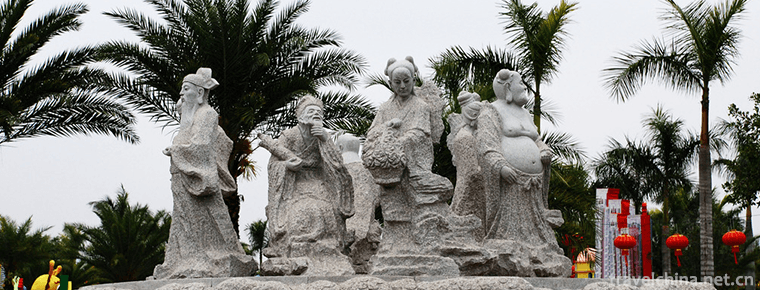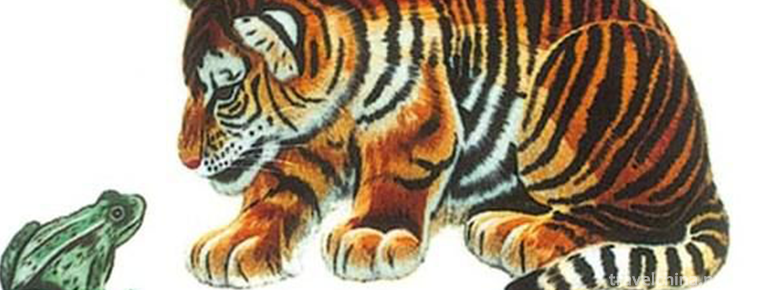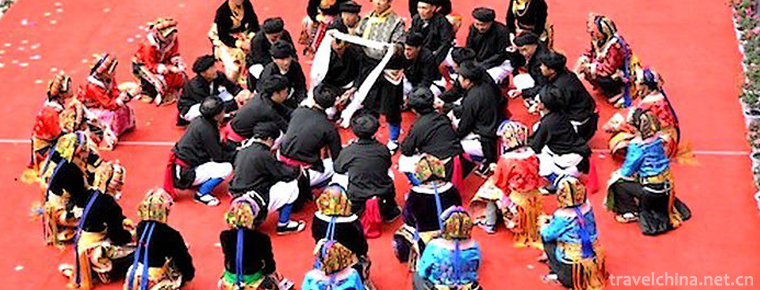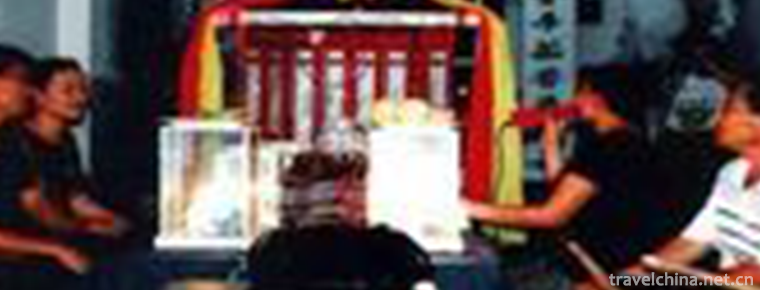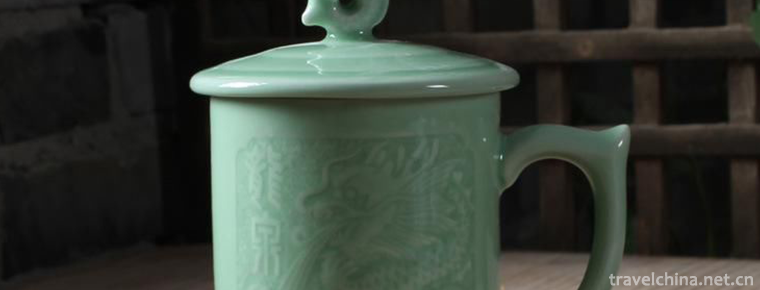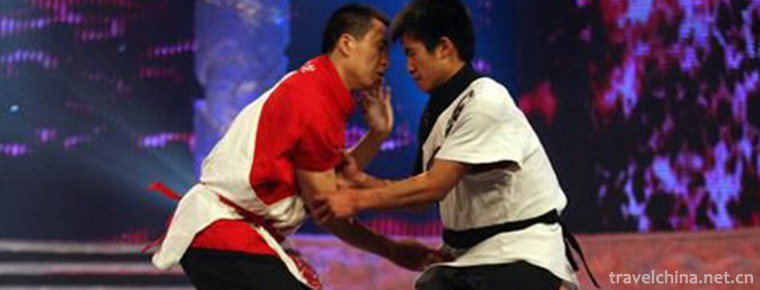Bai opera
Bai opera
After 1949, on the basis of blowing tunes, Bai folk opera "Dabenqu" tunes were further enriched and improved, renamed "Baiju". The Lyric forms are basically sung in Bai language and Chinese in the "Shanhua Style" commonly used in Bai poetry. There are more than 30 kinds of tunes in the singing. The rhythm of the performance is distinct, the rules are rigorous, the performance is relatively simple, and there are strict and fixed procedures.
On June 14, 2008, Baiju was approved by the State Council to be included in the second batch of national intangible cultural heritage list.
Form
Baiju music includes singing music and accompaniment music. Singing music consists of blowing tune and Dabenqu, and at the same time it absorbs and adapts some folk music. Accompaniment music includes Suonaqu cards of traditional blowing tune, percussion and triad cards of Dabenqu, as well as some folk playing music and singing and dancing music. Some singing tunes are divided into Xiaosheng, Xiaodan, Shadan and Xushengqiang according to their performances; others are divided into heroic tune, crying tune and bitter tune according to their identities and actions; others are divided into flat, high-pitched, one-character tune and flowing board according to their rhythm and singing method. In addition, there are "Wind and Snow", "Lesson" and Bai folk songs "Sparrow Tune", "Loach Tune", "Chaoshan Tune" and so on. Most of the lyrics are in the form of "Shanhua Style" of Bai nationality, namely "3715" or "7715", which is called "seven and a half sentences". Singing in Bai or Chinese, and speaking in Bai Yin. Characters play a variety of roles according to life, Dan, Jing and ugliness. The performance rules are strict and the rhythm is distinct. It is not only danceable, but also has some martial arts with strong expressive force. White opera only uses unique facial makeup of red, black, white, blue and purple to distinguish different characters. The accompaniment orchestra has developed into a mixed Chinese and Western Orchestra mainly composed of national instruments, besides retaining the traditional instruments of Suona and tri-strings.
Distribution area
Baiju opera is mainly spread in Dali Bai Autonomous Prefecture and some Bai inhabited areas in Lijiang City.
Draw materials
Of these 269 plays, 139 are based on novel romances, 7 are adapted from folktales and folk songs, 4 are evolved from ancient plays, 57 are transplanted from brotherly plays, and 62 are from other sources. It can be seen that the source of blowing operas is extremely rich.
Ethnic flavor
There are many distinct national characteristics in the traditional dramas of blowing tunes. First, blowing tunes are of strong literariness, and there are fewer common cliches in traditional operas. Many dramas are written by literati with elegant and beautiful diction. For example, Li Yongxiake, a scholar, wrote his poem with Ma Zhiyuan's Xiaoling Tianjingsha: "Dangui in mid-Autumn Festival in August, the residence on the road is desolate, the scent of Osmanthus blossoms flowing in the bridge, and we think about it day and night." Second, the lyric format of blowing tune is different from that of Han opera. It is basically the so-called "mountain flower style" of "37-5". That is to say, each Lyric paragraph is four sentences, the first three sentences are seven words, and the last one is five words. If the lyrics need to be longer, the two paragraphs are linked into eight sentences, the first seven sentences are seven words, the eighth sentence is five words, or let the two paragraphs die together. "Shanhua Style" is a traditional form of poetry in Bai literature. It is used in the form of folk songs, minors, major songs, literati poems and wishes sung by Wugong. Thus we can see the close relationship between blowing and blowing tunes and Bai literature. Thirdly, the dramas with blowing tunes have their own linguistic features. Language is a mixture of Bai Language and Chinese Language, and Bai Language is also written in Chinese characters, which are only marked by sentences.
Representative repertoire
For example, Cui Wenrui's lyrics in Cui Wenrui's Chopping firewood are as follows: "There is Zeng Cui Wenrui (my name is Cui Wenrui) in the Hard Strip, who goes to the mountains at low altitudes at night (chopping firewood every day) and feeds his old mother at night (chopping firewood to support my old mother). May she be 100 years old." In addition, although the play of blowing tone is written in Chinese characters, it is read in Chinese white pronunciation, so the rhyme is different from that of Chinese, and there is no difference between the two, so the upper and lower sentences can be mixed. After liberation, literary and artistic workers excavated and sorted out the traditional dramas of blowing tunes, and performed the traditional dramas of blowing tunes, such as Cui Wenrui Cutting firewood, Burning Mill, Dou Yi Xiake, Liu Yinji, Bamboo Forest Picking, Baipao Visiting, etc.
Big Ben tune
Dabenqu is a traditional Bai folk rap and singing art. Now the earliest Dabenqu can be seen is the "Stroke Tune" (925 A.D.) recorded in Nanzhao's "Upper Tang Emperor's Uncle Book" of the Five Dynasties Huiyao. It has been about 1,000 years since now. The style of the stone inscription "Mountain Flower Stele" is seven, seven, five, with a total of three rhymes and 20 couplets. Its structural style and "Five Dynasties Meeting" are still retained. The same is the style of poems used in Dabenqu Tanci. Three strings accompaniment is used in the performance of the song. The content of the song is mainly about historical themes and love life. When singing, one singer is the lead singer and one accompaniment. The music changes with the lyrics. Due to the difference of dialect, Dabenqu's aria can be divided into two major artistic schools: southern and northern. The Southern Opera is represented by the works of artist Yang Han and the Northern Opera by the black stars. The Southern cavity is divided into three chambers, nine boards and eighteen tunes, while the northern cavity is divided into three chambers, nine boards and thirteen fades. The Southern Tune is euphemistic and lyrical, while the Northern Tune is simple and rough.
Libretto format
Basically, it is the Bai rhyme "Shanhua Style", namely "3715" (the first three sentences are seven-character sentences, the fourth five-character sentences), or "7715" (the first seven sentences are seven-character sentences, the eighth five-character sentences). Its tune is called "seven and a half sentences". It is sung in both Bai and Chinese languages with more than 30 tunes. Some are in line with the line, such as Xiaoshengqiang, Xushengqiang, Xiaodanqiang and Dandanqiang, others are in line with the person's identity, feelings and actions, such as heroic, crying, horse-shaking and bitter tunes, some are in rhythmic singing, such as flat tune, high tune, flowing board, stacking board, one-character tune, others still have Erreed tune, wind and snow, lessons, etc. When singing, there is no accompaniment. Suona is used to connect the tune. The tune is usually long, complicated, exaggerated and expressive. It is used to foil the feelings and strengthen the rhythm of the acting action. Percussion music uses folk dance Gong and drum beating method, often used in conjunction with Suona.
The traditional repertoire of Bai opera includes story plays reflecting the struggling life of Bai people, such as "Blood Sweaters", "Mou Jiatuo's Opening up Heyang", "Fire Songming Tower" and so on. There are life plays, such as "Bath of the blind", "Zhang Luanzi Lidou", "Liu Chengwu Moving Benches", "Shishan Bill" and so on. In addition, there are historical stories such as Three Kingdoms, Shuo Tang and Yang Jia Jiang, which share the same themes as Yunnan Opera and other operas. The new scripts include "Red Three Strings", "Cangshan Red Plum", "Wangfuyun" and so on.
The Role of White Opera
Points of action: Zhengsheng, Xusheng, Heroic Sheng, Peanut (Xiaosheng); Lao Dan, Zhengdan, Huadan, Kudan, Wudan, Shadan; Black Jing, Red Face, Big Flower Face, Second Flower Face; Clown (robe belt), Middle Clown (scarf), Clown (Qigong umbrella newspaper).
Baiju opera has a clear rhythm, strict rules and retains the older features. It not only has a set of special dance programs, but also pays attention to martial arts. During the Qianlong reign of the Qing Dynasty, Yang Yongtong, a 72-year-old artist, was able to turn over his body when he performed The Two Monkeys Hanging Print. All walks of life have their own unique footwork, and pay attention to "one suit, two songs, three beats". That is, masquerade performances should first conform to identity and character, and to sing well, dance and performance movements must also be in touch with the music. White opera has a set of unique facial makeup, only red, black, white, blue and purple, no yellow, green, gold and silver, rough style, highlighting the character.
Baiju in Shanhua Style
In the northwest corner of Yunnan-Guizhou Plateau, mainly the Bai people's living area, the eastern part of which is the gentle Jinsha River basin, with two pearls - Erhai Lake and Dianchi Lake. The climate here is mild, the four seasons are like spring, the mountains and rivers are beautiful and the flowers are beautiful. Since the Warring States Period, a group of people migrating to the southwest (Yinsilk) and the local aborigines have merged into the main ethnic groups on this land. Generations after generations, together with the Han and other minority nationalities, have created a colorful history and culture of the Bai nationality. White opera is one of the bright camellias.
Bai nationality was once called Yunnan, Suo, Qian, Baiman, Bai and so on in the historical records of Han nationality in successive dynasties. Bai people call themselves "Baizi" and "Baini". When Dali Bai Autonomous Prefecture was founded in 1956, according to the wishes of the Bai people, the Bai nationality was adopted as the general ethnic name. Bai opera is the Bai opera genre named on this basis. From its origin, it should be traced back to "blowing tune" and "big song". That is to say, Baiju is a new kind of national drama which combines "blowing tune" and "Dabenqu".
Historical origin
In 1962, Dali Bai Autonomous Prefecture, based on the former Dali Blow Opera Troupe, selected some actors and performers from Dali Song and Dance Troupe to form the Autonomous Prefecture Bai Opera Troupe, which was the first professional troupe in the history of Bai Opera. Since its establishment 30 years ago, the Zhou Bai Opera Troupe has made remarkable achievements in reorganizing and adapting traditional operas, new historical dramas and creating and transplanting modern operas. There were 128 plays (songs), nearly 100. Especially in the creation of dramas, fruitful results, nearly 20 plays to participate in the Central and Provincial Drama Meetings and won awards. Written by Yang Ming, Chen Xing and Zhang Jicheng in 1980, Wangfuyun, a Bai mythological and legendary drama performed by Zhou Bai Opera Troupe, represents the performance style and artistic characteristics of a new generation of Bai Opera. In the content of the script, "Wangfuyun" not only retains the basic spirit of the original legend of the factory, resisting evil forces and striving for freedom of marriage, but also adds some plots with local national characteristics, skillfully combining the two Bai folklores of "Dragon and Phoenix Marriage" and "Baigui Girl" with the legend of "Wangfuyun", enriching and developing the plot. Although the lyrics of the new Baiju opera adopt the form of "Shanhua Style" of "371-5", they are not rigid and unchanged, but often break through according to the needs of the plot and the change of the characters'feelings. Some lyrics have more than ten sentences, and the most one has more than ten words, in order to meet the needs of expressing the complicated thoughts and feelings of the characters, and at the same time make the lyrics more operatic, and retain the strong flavor of Bai folk songs in the lyrics, fresh and unique. The singing style of Baiju opera integrates the traditional blowing tune with the Benqu tune, initially forming a slab tune body, while retaining the characteristics of the Lianqu style, which is more relaxed, free and expressive. For example, the tune of Wangfuyun is mainly composed of large volume songs, some blowing tunes and Bai folk tunes are also used, and breakthroughs are made according to the plot and the needs of the characters. Therefore, the opera not only maintains the style of the opera singing, but also makes the opera singing rich in change and expression, simple and fresh, pleasant and beautiful. The whole music style is from top to bottom, very chic, the use of interlinings has a unique flavor, the use of accompaniment is also appropriate. Especially in the "love fixing" a song around Sanglin, not only lyrics are used in folk songs, music is also folk songs, the atmosphere is warm and cheerful. In percussion music, Baiju also absorbs the characteristics of Peking Opera and Yunnan Opera, making the changes of tone intensity and intensity more coordinated and enhancing the expressive force. Although the performance of Baiju has a certain formula, it is not solidified and relatively free. In the design of dance, Baiju not only absorbs the folk bully whip and flower-dressing dance, but also adds solo dance, double dance and collective dance to make folk dance and opera performance harmonious and unified. In terms of stage and costume design, Baiju is mostly designed according to historical documents and ancient Nanzhao murals and sculptures, which not only keeps the historical reality, but also makes the costume and stage design of Baiju have distinct local national characteristics.
Introduction of Bai nationality
Bai nationality is a people who can sing and dance well. All aspects of their life can be shown by singing and dancing. For example, the minors in Dabenqu include Sheep-feeding tune, grave-climbing tune, forced mood, Memorial tune, soul-asking tune, homesickness tune, and folk dances include tea-picking dance, water-carrying dance, drunken dance, wine ceremony dance, end-plate toast dance, water-offering dance, etc. Speaking of Bai nationality's song and dance, we should mention Sima Xiangru, a poet of the Western Han Dynasty. In Shanglin Fu, he listed some famous music and dance songs popular in the Western Han Dynasty, including "Wencheng Belt Song". Sima Zheng in Tang Dynasty commented on "Wencheng Belt Song" in "Historical Records and Solutions": "Wencheng, the name of Liaoxi County, its people are good song. Ban, Ban County of Yizhou, whose people are good at composing Southwest Yi Songs. "Dian" is the word "Yunnan". Southwest Yi was a generic name for the minority nationalities in Southwest China in Han Dynasty. Sima Xiangru, who was well versed in music, had been sent to Southwest China on the orders of Emperor Wu. The ballad he narrated was not only a song, but also an art form that included song, dance and music. This is evidenced by the excavation of bronze musical instruments, figurines and decorative musical and dance models of bronze instruments in Shizhai Mountain, Jinning County, Binhuan County, Dianchi Lake, and Lijiashan, nearby rivers and rivers.
Sing the song
It is a general term, not the name of a song. It refers to the song of transgression and the song of transgression. Guifu, a Qing Dynasty man, said in his book Zapu Volume 10, "Continuation of a Tour to Yunnan", that the British Song was still popular among the minority nationalities in Southwest China in the Qing Dynasty. In fact, stepping on songs is only one of them. Stepping song, also known as stepping dance song, is one of the ancient forms of singing and dancing of minority nationalities in southwest China. It stayed on the ground in rhythm, singing and dancing. Ta Ge is called "Da Ge" in the Xishan area of Eryuan, Bai nationality. The Bai dialect "beat" has the meaning of "take-off". Like other ethnic minorities such as the Yi people, it is a kind of entertainment which combines poetry and dance while singing. His poems are free style, using the way of question-and-answer, the sentence does not require neatness, can be long or short, the rhyme is not too exquisite, can be pledged or not. Its song has simple tone, the change of tone and scale is not complicated, its dance mostly moves around the fire pond in a circle, the dance rhythm is mainly realized by neat footsteps, because hand in hand or holding wine or other things, the upper limb movement is relatively simple.
promote a new song by singing it frequently in public
It came into being at the latest in the Western Han Dynasty. Sima Xiangru guessed that there was a "song beating" in the ballad. At that time, the Bai nationality had no written language, and song-playing could only be handed down by oral language from generation to generation, and added or deleted by oral processing. The ancestors of the Bai nationality enjoyed their spiritual pleasure by singing and entertaining themselves, eliminating the cold, loneliness and fatigue at night; entertaining gods, namely, revering ghosts and gods to pray for happiness and security and to obtain spiritual comfort; and passing on the past to educate future generations not to forget their ancestors so as to obtain spiritual support. The Bai people have the saying that "the old do not pass down the ancient, the young lose their genealogy". Like the long narrative song "Creating Heaven and Earth" handed down, the narrative place is the process of Pangu Pan's creation. "Sheep Song" describes the nomadic life of ancient Yunnan people and proudly sings, "Dali is a good place, sheep are fat and fat. Dali is a good place. The wool is three feet and six feet long.
Following the expansion of the influence of Han culture, Bai people accepted Han folklores and historical stories naturally, and many dramatic chapters appeared, such as Reading Songs (Liang Zhu Story), Zhuge Liang, Chu Han Struggle and Eight Immortals Crossing the Sea. These songs just use the historical stories of Han folklore to express Bai national spirit, so they have distinct Bai national characteristics. For example, Liang Zhu's "Reading Song" changed Liu Yin's worship to Panasonic's. After that, he also visited Cangshan Mountain. In Pioneer of Heaven and Earth, brother and sister get married and say, "Who is the master? Pine is the master." Therefore, the Bai people from ancient customs, married people have the custom of planting a pair of pine trees in front of the colored house and paradise. Liang Zhu of the Han nationality did not write about the work of Liang Shanbo and Zhu Yingtai, while Liang Zhu in Reading Song built his own grass hall, made tables and stools, carried water and cooked food by himself, and changed the plot of "Eighteen Sendings" into a trial of playing chess and pipa. At the end, Yingtai went to Shanbo's grave and dug out two sticks from the grave with a gold hoe. Two sticks were thrown into the river and turned into two goldfish. Two goldfish were netted and buried by the river and two willow trees. Then use the golden axe to cut the willow trees, and cut the pieces of wood to fly to the butterflies. Finally, Liang Zhu became a pair of double ducks, and Ma Wen became a single duck. The plot of the story is strengthened, so that it has the basis of affinity with the opera. Also associated with opera are songs and dances around Sanling. The Bai language of "around three spirits" is called "Sana", which is a song and dance festival held by Bai people in Dali from April 23 to 25 in the lunar calendar. The bamboo stick that dresses up as an old man in three spirits and hangs a small gourd in his hand is probably the evolution of the divine tree, that is, the Mulberry tree. The gourd is a worship object closely related to reproduction. Its origin is the same as the "social drink" of the ancient worship of the life "society" of the Han nationality, that is, the free intercourse ceremony of meeting men and women, Carnival and dancing in the flourishing season of life - spring club. The Bai people have many legends about the evolution of the song and dance rituals around the three spirits. For example, there was a year of drought in Dali in ancient times. When it came to seedling planting season, the rain did not fall and the seedlings could not be planted. Later, the people gathered in the Nine Halls of Xizhou to build a prayer platform for the rain, praying for the rain, and on April 25, it really rained. From then on, the people believed in the Lord very much. Every year on April 25, they went to the temple of the Lord to pray for rain. There is also a legend that the three spirits around are mourning for a dead emperor who loved his people. Obviously, with the development of Bai society, the owner replaced the owner. Zhang Wenxun's "Bai Literature History" recorded this legend, saying that an ancient Bai Emperor died, "because he was able to administer benevolent government in his lifetime, the people loved him. After his death, the people rushed to mourn for him, holding a pestle funeral stick and a willow branch, hanging white cloth and water bowl on willow trees to express their mourning for the Emperor, this form once a year. Later, the funeral club in people's hands became a bully whip, the water bowl became a money drum, and the willow branches were hung with red cloth instead of white cloth.
Around Sanling to the Qing Dynasty, its musical tunes absorbed a large number of Bai folk songs and dances. For example, "Digging Water Tune", "Going Out Tune", "Dali Ancient Landscape", dancing is the bully whip, money inspiration, playing gongs and drums, flutes, suona and so on.
In Bai literati's poems of Qing Dynasty, this is described as: "Money drum, king whip, hands deliberating arm rotation, the most is the sister-in-law's song, the voice singing into the love of heaven." Duan Bian, a Bai poet in Xianfeng's reign, wrote CI about three Lingzhu branches.
"Song singing people's family casual way", around the three spirits is walking while singing, impromptu compilation, is basically the Bai tune lyrics form of "July 7th Five-Year Plan", which is in line with the Dabenqushan flower-style lyrics. Any national opera can not be separated from the cultural nourishment of its own nation, but also from the influence of other national cultures. The Bai nationality's big songs and blowing tunes are developed on the basis of Bai nationality's folk songs, dances and raps.
Daben is composed of hundreds of Bai tunes, usually accompanied by three strings and suona. In the course of its development, it gradually formed the art of rap, singing and dancing comprehensive opera. When did Dabenqu come into being? Some said it originated in Tang Dynasty, others said it originated in Ming Dynasty. If we only look at the form of the Lyric "775" Shanhua Style, it is not convincing to deduce that the origin of Dabenqu in Tang Dynasty. Because the Bai nationality's comprehensive art with the embryonic form of opera is bound to be influenced by the Han nationality's local opera, and the rise of the Han nationality's local opera is exactly the period of Yongzheng and Qianlong in the Qing Dynasty, so the rise and spread of the Daben opera can only come after that.
Early Big Bend
It is a person who plays and sings by himself with three strings in his arms. The singing tune is Bai nationality tune, which developed to 18 tunes later. Eighteen tunes are the minor tunes in the aria, including crab tune, old sparrow tune, new sparrow tune, flower score tune, genealogy tune, Pipa tune, flower tune, sheep tune, grave tune, Tao tune, Memorial tune, Yin-yang tune, classical tune, Buddhist tune, soul tune, homesickness ridge, blood Lake pool, honey gathering, etc.
A Cloud Named Looking-For-You
Yang Ming, a Bai playwright, wrote Bai opera according to Bai folklore. In mid-November 1980, the Bai Opera Troupe of Dali Bai Autonomous Prefecture brought it to Beijing for a performance and performed 11 performances in the Palace of National Culture. In the play, the protagonist, Princess Afeng, is played by Ye Xintao and the hunter, Aaron, is played by Yang Yongzhong. The opera's aria is a good combination of Bai nationality's main song and blowing tune, which not only expresses euphemism and delicacy, but also expresses more lively thoughts and emotions. According to the development of the plot and the need of the characters'performance, dance scenes with Bai customs and folklore are arranged, such as "around the mountain forest", "bully whip", "gift of divine wings", "fairy scattering flowers" and so on. It was well received by the audiences in the capital.
The story of Wangfuyun also came into being in Nanzhao era. It tells us that a princess of Nanzhao Wang, A Feng, was very beautiful. She later fell in love with a handsome and brave hunter, A Long. In order to pursue a free and happy love life, she escaped from the palace with the hunters and went to live happily on the Southern Bureau peak on the top of Cangshan Mountain. When King Nanzhao learned that the princess had fled, he asked Master Luo to break the hunter into the Erhai Lake and turn him into a mule. Princess Nanzhao died in grief because she longed and missed her lover. After her death, she turned into a white cloud. Every year in August and September, when the white clouds appeared, a strong wind would blow. It was not calm until she saw a mule in the Erhai Lake. Bai people sympathize with the princess and call this beautiful white cloud "Wangfuyun".
Large-scale Modern White Opera "Warm Cangshan"
Modern Baiju opera "Love Warm Cangshan" takes Bai's rural life as the background, and takes the contradictions and entanglements between Tian Xiulan and her husband, Manager Zhao, brother Tian Jinsheng, and Liu Erbao in the countryside as the plot. It describes the simple and kind family of Liu Erbao, who suffered from the black pot, and Axiu Xiangchang struggled out of the mud of family affairs, revealing the story of the opposite thinking. It portrays the image of a township head who exchanges sentiment for love and is open and straightforward as an official. It shows the characters and customs of modern Bai rural areas.
In "Meeting the New Century 2000 Yunnan New Opera (Festival) Show", the play received unanimous praise from the audience, experts and leaders, and ranked without dispute at the top of the award-winning drama (festival) in this exhibition. Critics believe that the success of the play lies not in catching up with the fashionable "new", but in honest "true", in truth and truth, and truth is the life of art. As far as the selection of materials is concerned, there is nothing new in "Qingnuangshan". It is just a common occurrence of false pesticides and seeds in the countryside. There is nothing particularly surprising about the plot of the story. The play revolves around the wedding banquet of Changtian Xiulan, a peasant named Liu Erbao, who burned his crops with fake pesticides, and the investigation of the source of fake pesticides by Tian Xiulan. The playwright's function is to concentrate, refine and generalize such a common event, so that it can be typified, without departing from the basic principles of traditional realism. The setting of dramatic plots, the composition of the relationship between characters, the unfolding of plots, the development of characters'personality, the promotion of dramatic contradictions and conflicts, and the application of suspense, expectation and sudden change are all natural and smooth, without any artificial feeling. They are in line with both the logic of life and the emotional logic of the characters in the prescribed situations, thus making the reality of life and the reality of art more realistic. Good unity makes the audience feel authentic and willing to accept it, which lays a good foundation for the success of theatrical performance. Truth is the life of art, and true feeling is the life fountain of art. The success of Love Warm Cangshan lies in that it writes true feelings and touches people with true feelings. In the play, a series of dramatic conflicts are launched around tracing the source of false pesticides, all around a word of "emotion". Family, local conditions, the flesh and blood feelings of the Party and the people are the core of the play. Tian Xiulanmei, the head of the township, has twice opened her eyes. She is deeply attached to her newly married husband, Manager Zhao, and her brother Tian Jinsheng, who has been holding hands with her, has depended on her since childhood. What never imagined is that the man who sells fake pesticides is his own brother and also pulls out his new husband, and the fake pesticide is his own hand from his husband. The company bought Liu Erbao for her. The misunderstanding caused by this double coincidence is that it is difficult to get rid of the mistake of jumping into the Yellow River. On the other hand, Liu Erbao, who suffered from false pesticide poisoning, is exactly her father and fellow countrymen who have lived in harmony for 20 years and nurtured her growing up. What is more serious is that, as a township head, the false pesticide incident not only affects the family reputation, her prestige among the masses, but also directly affects the image of the party and the flesh and blood feelings of the party and the masses. Tian Xiulan is not a saint. She needs family and family. She can't bear the loss of her father and her fellow countrymen. She can't bear to see Liu Erbao, who has suffered from pesticide poisoning, suffered unjustified grievances. Instead, she has to apologize. The tremendous impact of all kinds of emotions has made her fall into a very complex and difficult emotional network. It is even more difficult to make a decisive decision. The most difficult thing to cut off is love, the most tortured is love, and the most difficult choice is love. The script places Tian Xiulan in the dilemma of this difficult choice of true feelings, launches the inner emotional struggle between family feelings, homesickness, the blood and flesh feelings of the party and the masses, and presents the richness, authenticity, nobility and personality charm of the characters'inner world emotions to the audience in this struggle. People feel lovely, lovely and respectable, so that they have fully accepted the image of Tian Xiulan, the head of the township, both emotionally and intellectually, and of course accepted the theme of the play.
Mayor of Xiu
In 2000, the play won five awards for excellent drama, script creation, performance, dance design and music creation. In 2001, it won six awards for drama, performance and music in the 7th China Drama Festival. Later, it was renamed "A Xiuxiang Chang" and made into a drama and TV play, which was broadcast nationwide.
The playwright: Wei Shusheng; Director: Lipeng; Music Design: Wang Maolin, Zhang Liangshan; Dance Beauty Design: Zhang Shoupei, Jiangguo, Yang Guangbing, Yang Yueming; Main actors: Ye Xintao, Yang Yikun, Ma Yongkang, Zhao Wensheng, Dong Hanxian, Peng Qiang, Zhao Xianzhi, Yang Liu Zhong, etc.
Bai Opera - Bai Dance in Dali, Bai Opera in Dali, also known as "Bai Opera". Originally known as blowing tune, short for "blowing tune", Dali Baiju opera is a new type of opera developed by absorbing the tunes of Dali Bai's Dabenqu, some Dali Bai's music and dance and Yunnan Yunnan Dianju opera music since 1958. Blow tune, originally popular in Dali Bai nationality area, has a complete range of acts, such as Sheng, Dan, Jing, Du, Ugly, etc. There are certain performance procedures, and there are more than 30 kinds of singing tunes, most of which are famous according to their acts and plots. Bai Baiju Baiju opera music is accompanied by Suona interlude, singing and dancing during the performance. The costume and facial makeup are roughly the same as those of classical Chinese drama. The Bai opera scripts of Dali include Dou Yi Xiake, Liu Yinji, Biography of Python Snake, Fire Songming Tower, Bloody T-shirt, Du Chao Xuan and Zhao Long Guan Deng. The lyrics of Dali Bai opera are "Shanhua Style" and the dialogues are Dali Bai mixed with Chinese, but the Chinese characters should be read in white. Before 1949, there were no professional opera gangs (classes) in Dali Bai opera, but self-entertaining Bai folk organizations. In 1959, the "Dali Bai Autonomous Prefecture Blow Opera Troupe" was formally established, and in 1962 it was changed to "Dali Bai Autonomous Prefecture Bai Opera Troupe". In the aspect of singing, the main part is the big song, absorbing the blowing tune, singing with three strings and suona accompaniment, and using percussion music to control the rhythm. Dali Bai Bai Opera has performed such large-scale plays as "Blood Shirt", "Wangfuyun", "Red Three Strings", "Cangshan Huimeng", "Madame Baijie", "Peacock Gall" and "Princess Agai" to explore the development of Dali Bai Opera. Nowadays, Baiju opera has become an important kind of opera for ethnic minorities in China.
The White Opera Princess Agai
Drawing on the story of Gong in the middle of Nanzhao's history, it shares a story with Guo Moruo's famous drama Peacock Gall. At the end of the Yuan Dynasty, Liang Wang, the ruler of the Yuan Dynasty in Yunnan, in order to enclose Duan Gong, the general manager of Dali, matched his daughter Agexu with Duan Gong as his wife in order to stabilize the rule of the Yuan Dynasty in Yunnan. Duan Gong has won the hearts and minds of the people with his outstanding wisdom and easy-going character. In the meantime, King Liang was afraid that Duan Gong would threaten his rule because he listened to the slanders of adulterers, so he ordered his daughter (Duan Gong's wife) Agai to kill Duan Gong with poisonous wine made of peacock gall. Princess Agai, a kind and beautiful grassland princess, did not submit to power, violated her father's orders, and dissuaded Duan Gong from fleeing to Dali to avoid disaster. However, Duan Gong, upright and upright, firmly believed that innocent people would be able to wash themselves out. She wanted to "distinguish right from wrong" with King Liang. Shila, a traitor, laid an ambush. Duan Gong was eventually killed by King Liang. When Again's husband was killed, he drank the poisonous liquor that his father, King Liang, had tried to poison Duan Gong to kill his husband.
Princess Agai, a white opera, is composed of five scenes, namely "bestowing husband", "quaff", "persuading husband", "fufu" and "martyr". The six words before "fu" form doubts and dramatic motives of contradiction and conflict. It pushes forward and waves overlap layer by layer, and deduces a life tragedy that makes people grieve and lament. When the playwright creates the play, his artistic viewpoint is very distinct. The playwright must follow his own path. The creation of the play must be based on the Bai culture and reflect the typical image of the national history and modern life. The creation of the white opera Princess Agai is the product of this idea. Although the theme is the same as Mr. Guo Moruo's famous drama Peacock Gall, the creation of which undoubtedly finds itself difficult, the playwright has a unique way to re-read history from the cultural perspective of the Bai people, with "Mongolian girl Agai is our good daughter-in-law of the Bai people" as the emotional main line, to follow his own path and re-arrange scenes and stories. The script still writes Palace opera, but it is filled with the affection of husband and wife, father and son, and human nature, which makes the story full of solemn and solemn color, and extends Duan Gong's death to the height of "the nation must unite".
Influence
After the launch of Princess Agai, she has won the first prize of comprehensive performance, first prize of performance, first prize of music, silver prize of repertoire creation, the first prize of performance in the third Chinese Art Festival, the first prize of excellent repertoire performance in the first group of the world, and the single prize of "Wenhua". The script won the silver prize of Yunnan Provincial Government. In 1996, it was selected as the "Opera Collection" of CCTV.
Introduction to famous artists
Xin Tao Ye
A beautiful sister of Sichuan, known as "Cangshan a flower". After the founding of New China, Baiju was highly valued by the Party and the people's government. The Dali Baiju Troupe came into being in 1962, which is an important milestone in the development of Baiju. Any kind of drama has its own group of actors, because its artistic characteristics and functions are all displayed by actors. Among the performers of the White Opera Troupe, Ye Xintao is a leader in connecting the past with the future. Ye Xintao, who entered the stage of Baiju in the early 1970s, struggled and roamed in the sea of Baiju art with his unique artistic talent and his assiduous "strength". After 30 years of hard work and dedication, Ye Xintao has become an excellent performing artist of Baiju opera with skilled acting skills and numerous achievements. The snow of Cangshan Mountain and the water of Erhai Lake moisten her long-standing golden voice. Her singing of Bai Song and Bai Opera is like the sweet water of eighteen streams, which flows into people's hearts constantly.
inherit
In 2008, Baiju Opera was selected as the second batch of national intangible cultural heritage, which is of great significance to the promotion of Chinese culture and the great development and prosperity of socialist culture.
In 2014, the Yunnan Provincial Party Committee and the government have agreed to incorporate the office and business housing of Baiju into the upcoming project of Dali Mass Cultural Activities Center; the "Butterfly Dream" Theatre will be used by the State Ethnic Culture Working Group (that is, Baiju Troupe); the Baiju Research Room, Baiju Creation Room and Heritage and Exhibition Room will be added to the Baiju Cultural Tradition; and the Fourth Major Arts School of Dali and Xiaguan will be set up. Primary school is set up as "Baiju Heritage Base"...


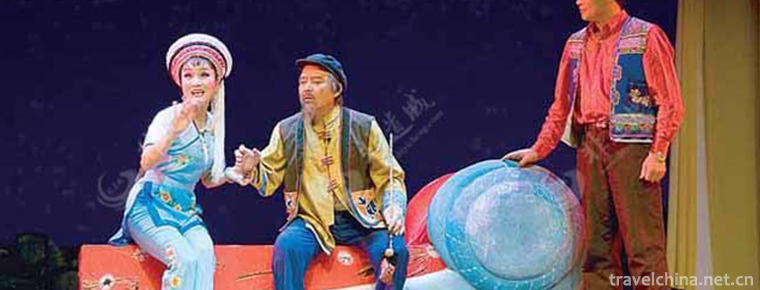
-
Chaibuxi Canyon Scenic Area
Chaibuxi Canyon Scenic Area is located in the eastern part of Wufeng Tujia Autonomous County, with Wulingyuan in the South and Qingjiang River in the north. Zhangjiajie belongs to Wuling Mountains..
Views: 217 Time 2019-01-04 -
Legend of Eight Immortals
The legend of Eight Immortals is one of the local folklores in Shandong Province. The legend of Eight Immortals originated very early. The legend of "Eight Immortals Crossing the Sea, Each Showin.
Views: 209 Time 2019-04-02 -
Carrying a number
Handling trumpets is one of the trumpets of traditional folk songs. It is popular in many fields, such as manual workers, such as loading and unloading, lifting, pushing and pulling goods..
Views: 462 Time 2019-04-03 -
Beipiao Folk Stories
Beipiao Folklore is a local folk literature in Liaoning Province. It includes eight categories: folklore, character legend, fantasy story, life story, animal and plant story.
Views: 170 Time 2019-04-04 -
Bian Embroidery
Bian embroidery, one of the traditional Chinese embroidery techniques, has a long history and is known as "national treasure". It is famous for its exquisite embroidery,.
Views: 331 Time 2019-04-04 -
Bo Ba Shen en
Bobassengen is a unique folk large-scale narrative mass pot village dance created by Ganbao Tibetan Village in Jiarong Tibetan area, Lixian County, Sichuan Province. "Boba" .
Views: 390 Time 2019-04-04 -
Drum bowl song
Drum-pot song is a very ancient traditional form of music and art in Hubei Province of China. It originates from the traditional folk activities of "beating a pot as a drum, singing with the fune.
Views: 85 Time 2019-05-01 -
Ha Ni Ha Ba
Ha Ni Ha Ba, an important part of Chinese Hani folk literature. Hani Haba, which means Hani ancient songs, is a popular and far-reaching folk song in Hani social life..
Views: 343 Time 2019-05-02 -
Gourd sculpture
There are two techniques for carving gourds. One is to use three kinds of special steel needles, large, medium and small, to carve the landscape, flowers and characters in the gourd.
Views: 386 Time 2019-05-03 -
Firing Techniques of Longquan Celadon
Longquan celadon firing technology, the traditional ceramic technology of Longquan City, Lishui, Zhejiang Province, is one of the national intangible cultural heritage..
Views: 118 Time 2019-05-14 -
Back to back entanglement
Tongbei Bianquan, also known as Hongdong Tongbeiquan, is a complete and systematic set of traditional boxing. It combines the advantages of both inside and outside. It is divided into mother boxing an.
Views: 133 Time 2019-06-21


